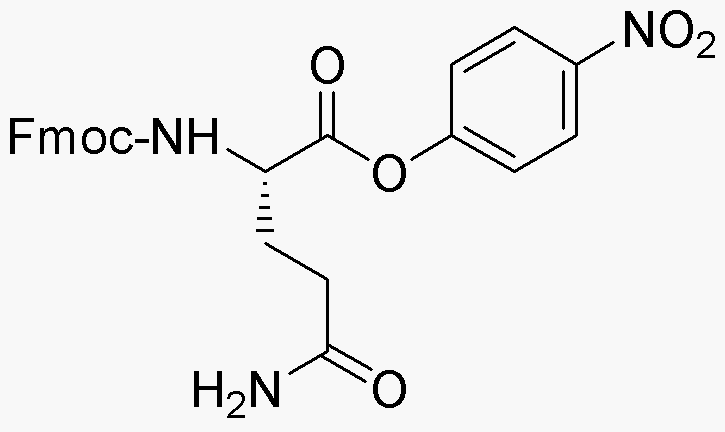Fmoc-L-glutamine 4-nitrophenyl ester is widely utilized in research focused on:
- Peptide Synthesis: This compound serves as a key building block in the synthesis of peptides, allowing for the incorporation of glutamine residues. Its protective Fmoc group simplifies the process of sequential amino acid addition.
- Drug Development: Researchers use this ester in the design of peptide-based pharmaceuticals, particularly in developing drugs targeting specific biological pathways, enhancing therapeutic efficacy.
- Bioconjugation: The compound is valuable in bioconjugation techniques, enabling the attachment of peptides to various biomolecules, which is crucial for creating targeted drug delivery systems.
- Protein Engineering: In the field of protein engineering, it aids in modifying proteins to improve their stability and functionality, which is essential for biotechnological applications.
- Analytical Chemistry: This chemical is utilized in analytical methods to study protein interactions and dynamics, providing insights into biological processes and potential therapeutic targets.
General Information
Properties
Safety and Regulations
Applications
Fmoc-L-glutamine 4-nitrophenyl ester is widely utilized in research focused on:
- Peptide Synthesis: This compound serves as a key building block in the synthesis of peptides, allowing for the incorporation of glutamine residues. Its protective Fmoc group simplifies the process of sequential amino acid addition.
- Drug Development: Researchers use this ester in the design of peptide-based pharmaceuticals, particularly in developing drugs targeting specific biological pathways, enhancing therapeutic efficacy.
- Bioconjugation: The compound is valuable in bioconjugation techniques, enabling the attachment of peptides to various biomolecules, which is crucial for creating targeted drug delivery systems.
- Protein Engineering: In the field of protein engineering, it aids in modifying proteins to improve their stability and functionality, which is essential for biotechnological applications.
- Analytical Chemistry: This chemical is utilized in analytical methods to study protein interactions and dynamics, providing insights into biological processes and potential therapeutic targets.
Documents
Safety Data Sheets (SDS)
The SDS provides comprehensive safety information on handling, storage, and disposal of the product.
Product Specification (PS)
The PS provides a comprehensive breakdown of the product’s properties, including chemical composition, physical state, purity, and storage requirements. It also details acceptable quality ranges and the product's intended applications.
Certificates of Analysis (COA)
Search for Certificates of Analysis (COA) by entering the products Lot Number. Lot and Batch Numbers can be found on a product’s label following the words ‘Lot’ or ‘Batch’.
Número de catálogo
Número de lote/lote
Certificates Of Origin (COO)
This COO confirms the country where the product was manufactured, and also details the materials and components used in it and whether it is derived from natural, synthetic, or other specific sources. This certificate may be required for customs, trade, and regulatory compliance.
Número de catálogo
Número de lote/lote
Safety Data Sheets (SDS)
The SDS provides comprehensive safety information on handling, storage, and disposal of the product.
DownloadProduct Specification (PS)
The PS provides a comprehensive breakdown of the product’s properties, including chemical composition, physical state, purity, and storage requirements. It also details acceptable quality ranges and the product's intended applications.
DownloadCertificates of Analysis (COA)
Search for Certificates of Analysis (COA) by entering the products Lot Number. Lot and Batch Numbers can be found on a product’s label following the words ‘Lot’ or ‘Batch’.
Número de catálogo
Número de lote/lote
Certificates Of Origin (COO)
This COO confirms the country where the product was manufactured, and also details the materials and components used in it and whether it is derived from natural, synthetic, or other specific sources. This certificate may be required for customs, trade, and regulatory compliance.


